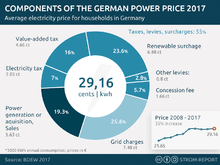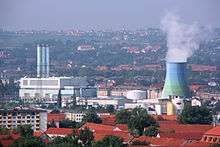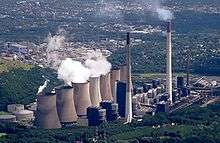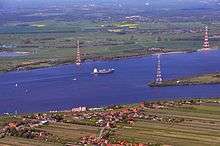Electricity sector in Germany
Germany's electrical grid is part of the Synchronous grid of Continental Europe. In 2019, Germany produced 516 TWh of electricity of which 46% was from renewable energy sources, 29% from coal, and 10% from natural gas.[2] This is a major change from 2018, when a full 38% was from coal, only 40% was from renewable energy sources, and 8% was from natural gas.[5]
| Data | |
|---|---|
| Continuity of supply | 0.2815 hrs (16.89 min) interruption per subscriber per year |
| Installed capacity (2020) | 211.31 GW[1] |
| Production (2019) | 515.56 TWh[2] |
| Share of fossil energy | 39.8% (2019)[2] |
| Share of renewable energy | 46.1% (2019)[2] |
| GHG emissions from electricity generation (2013) | 363.7 Mt CO 2 [631.4 TWh × 576 g/kWh] |
| Residential consumption | % |
| Average industrial tariff (US$/kW·h, 2013) | medium: 20.60[3] |
- Nuclear: 71.09 TWh (13.8%)
- Brown Coal: 102.18 TWh (19.9%)
- Hard Coal: 48.69 TWh (9.5%)
- Natural Gas: 54.05 TWh (10.5%)
- Wind: 127.22 TWh (24.8%)
- Solar: 46.54 TWh (9.1%)
- Biomass: 44.42 TWh (8.7%)
- Hydro: 19.23 TWh (3.7%)
.png)
Even though renewables production increased significantly between 1991 and 2017, fossil power production remained at more or less constant levels. In the same period, nuclear power production decreased, much of the increase in renewables had to be spent to fill the gap left behind by closing nuclear power plants. Germany will phase-out nuclear power by 2022, meaning that future growth in renewables will be needed to fill the gap again. Germany also plans to phase out coal, but not until 2038.[6]
Electricity prices
German prices in 2017 were €29.16 cents per kwh for residential customers, an increase of 35% over 2008.[7]

German households and small businesses pay the second highest electricity price in Europe for many years in a row now. More than half of the power price consists of components determined by the state. These include charges for using power grids (24.6%), levies for financing investment in renewable energy (22.1%) and for other kinds of taxes (e.g. GST 16%).[7]
Electricity trade in Germany
Germany, the largest exporter of electricity with 10% of the overall exports, reinforced its position as a net exporter by 20% during the year 2010[8] Germany has grid interconnections with neighboring countries representing 10% of domestic capacity.[9]:5
Electricity per person and by power source
Germany produced power per person in 2008 equal to the EU-15 average (EU-15: 7,409 kWh/person) and 77% of the OECD average (8,991 kWh/person).[10]
On 8 May 2016 renewables supplied 87.6% of Germany's national electricity consumption, albeit under extremely favourable weather conditions.[11]:11
| Use | Production | Export | Exp. % | Fossil | Fossil % | Nuclear | Nuc. % | Other RE* | Bio+waste | Wind | Non RE use* | RE % | |
|---|---|---|---|---|---|---|---|---|---|---|---|---|---|
| 2004 | 7,445 | 7,476 | 32 | 0.4% | 4,603 | 61.5% | 2,025 | 27.2% | 654 | 194 | 6,597 | 11.4% | |
| 2005 | 7,468 | 7,523 | 55 | 0.7% | 4,674 | 62.1% | 1,977 | 26.5% | 670 | 201 | 6,597 | 11.7% | |
| 2006 | 7,528 | 7,727 | 199 | 2.6% | 4,796 | 62% | 1,706 | 22.7% | 856 | 369 | 6,303 | 16.3% | |
| 2008 | 7,450 | 7,693 | 243 | 3.3% | 4,635 | 60% | 1,804 | 24.2% | 873 | 381 | 6,196 | 16.8% | |
| 2009 | 7,051 | 7,200 | 149 | 2.1% | 4,314 | 59.9% | 1,644 | 23.3% | 288* | 491 | 461* | 5,811 | 17.6% |
| 2017 | 6,038 | 6,678 | 640 | 9.5% | 3,199 | 48.6% | 873 | 13.2% | 711 | 574 | 1,252 | 3,501 | 38.2% |
| * This data for Germany is extracted from the international column of a Swedish report * Other RE is waterpower, solar and geothermal electricity and wind power until 2008 * Non RE use = use – production of renewable electricity * RE % = (production of RE / use) * 100% Note: European Union calculates the share of renewable energies in gross electrical consumption. | |||||||||||||
Mode of production
.png)


According to the IEA the gross production of electricity was 631 TWh in 2008 which gave the seventh position among the world top producers in 2010. The top seven countries produced 59% of electricity in 2008. The top producers were the United States (21.5%), China (17.1%), Japan (5.3%), Russia (5.1%), India (4.1%), Canada (3.2%) and Germany (3.1%).[14]
In 2019, Germany generated electricity from the following sources: 29% coal, 25% wind, 14% nuclear, 10% natural gas, 9.1% solar, 8.7% biomass, 3.7% hydroelectricity.[2]
Coal
In 2008, power from coal supplied 291 TWh or 46% of Germany's overall production of 631 TWh, but this dropped to 204 TWh (38%) in 2018 and 151 TWh (29%) in 2019.[4] In 2010 Germany was still one of the world's largest consumers of coal at 4th place behind China (2,733 TWh), USA (2,133 TWh) and India (569 TWh).[14] By 2019 it had fallen to 8th, behind smaller countries such as South Korea and South Africa.[15]
In January 2019 the German Commission on Growth, Structural Change and Employment initiates Germany's plans to entirely phase out and shut down the 84 remaining coal-fired plants on its territory by 2038.[6]
Nuclear power
Germany has defined a firm active phase-out policy of nuclear power. Eight nuclear power plants were permanently shut down after the Fukushima accident. All nuclear power plants are to be phased out by the end of 2022. According to BMU this is an opportunity for future generations.[16]
Siemens is the only significant nuclear constructor in Germany and the nuclear share was 3% of their business in 2000.[17] In 2006 large international bribes by Siemens in the energy and telecommunication business were revealed. The case was investigated, for example, in Nigeria, the United States, Greece and South Korea.[18]
The installed nuclear power capacity in Germany was 20 GW in 2008 and 21 GW in 2004. The production of nuclear power was 148 TWh in 2008 (sixth top by 5.4% of world total) and 167 TWh in 2004 (fourth top by 6.1% of world total).[14][19]
In 2009, nuclear power production saw a 19% reduction compared to 2004, and its share had declined smoothly over time from 27% to 23%. The share of renewable electricity increased, substituting for nuclear power.[10]
Renewable electricity

.png)
Germany has been called "the world's first major renewable energy economy".[20][21] Renewable energy in Germany is mainly based on wind, solar and biomass. Germany had the world's largest photovoltaic installed capacity until 2014, and as of 2016, it is third with 40 GW. It is also the world's third country by installed wind power capacity, at 50 GW, and second for offshore wind, with over 4 GW.
Chancellor Angela Merkel, along with a vast majority of her compatriots, believes, "As the first big industrialized nation, we can achieve such a transformation toward efficient and renewable energies, with all the opportunities that brings for exports, developing new technologies and jobs".[22] The share of renewable electricity rose from just 3.4% of gross electricity consumption in 1990 to exceed 10% by 2005, 20% by 2011 and 30% by 2015, reaching 36.2% of consumption by year end 2017.[23] As with most countries, the transition to renewable energy in the transport and heating and cooling sectors has been considerably slower.
More than 23,000 wind turbines and 1.4 million solar PV systems are distributed all over the country.[24][25] According to official figures, around 370,000 people were employed in the renewable energy sector in 2010, particularly in small and medium-sized companies.[26] This is an increase of around 8% compared to 2009 (around 339,500 jobs), and well over twice the number of jobs in 2004 (160,500). About two-thirds of these jobs are attributed to the Renewable Energy Sources Act.[27][28]
Germany's federal government is working to increase renewable energy commercialization,[29] with a particular focus on offshore wind farms.[30] A major challenge is the development of sufficient network capacities for transmitting the power generated in the North Sea to the large industrial consumers in southern parts of the country.[31] Germany's energy transition, the Energiewende, designates a significant change in energy policy from 2011. The term encompasses a reorientation of policy from demand to supply and a shift from centralized to distributed generation (for example, producing heat and power in very small cogeneration units), which should replace overproduction and avoidable energy consumption with energy-saving measures and increased efficiency.
Transmission network
Grid owners included, in 2008, RWE, EnBW, Vattenfall and E.ON. According to the European Commission the electricity producers should not own the electricity grid to ensure open competition. The European Commission accused E.ON of the misuse of markets in February 2008. Consequently, E.ON sold its share of the network.[32] As of July 2016 the four German TSOs are:
- 50Hertz Transmission GmbH (owned by Elia, formerly owned by Vattenfall)
- Amprion GmbH (RWE)
- Tennet TSO GmbH (owned by TenneT, formerly owned by E.ON)
- TransnetBW (renamed from EnBW Transportnetze AG and a 100% subsidiary of EnBW)
In Germany, there also exists a single-phase AC grid operated at 16.7 Hz to supply power to rail transport, see list of installations for 15 kV AC railway electrification in Germany, Austria and Switzerland.
Elbe Crossing 1

Elbe Crossing 1 is a group of masts providing an overhead crossing of a 220 kV three-phase alternating current electric powerline across the River Elbe.[33] Constructed between 1959 and 1962 as part of the line from Stade to Hamburg north, it consists of four masts. Each of the two portal masts is a guyed mast 50 metres in height with a crossbeam at a height of 33 metres. One of these masts stands on the Schleswig-Holstein bank of the Elbe and the other on the Lower Saxony bank. Two identical carrying masts 189 metres in height, each weighing 330 tons, ensure the necessary passage height of 75 metres over the Elbe. One stands on the island of Lühesand, the other in the Buhnenfeld on the Schleswig-Holstein side.
Because of the swampy terrain, each mast's foundation is built on pilings driven into the ground. The Lühesand portal mast rests on 41 pilings and the one on the Buhnenfeld on 57. In contrast to the usual construction of such lattice-steel transmission towers, the direction of the line passes diagonally over the square ground cross section of the pylon, resulting in savings in material. The two crossbeams for the admission of the six conductor cables are at a height of 166 metres and 179 metres. The mast on the Buhnenfeld bears at a height of 30 metres a radar facility belonging to the Water and Navigation Office of the Port of Hamburg. Each portal mast has stairs and gangways for maintenance of flight safety beacons, and has a hoist for heavy loads.
Elbe Crossing 2
Elbe Crossing 2 is a group of transmission towers providing overhead lines for four 380 kV three-phase alternating current (AC) circuits across the German river Elbe.[34][35] It was constructed between 1976 and 1978 to supplement Elbe Crossing 1, and consists of four towers:
- A 76-metre-tall anchor pylon located in Lower Saxony, on the Elbe's southern banks.
- Two carrying pylons, each 227 metres tall. One is located on the island of Lühesand and the other is near Hetlingen in Schleswig-Holstein, on the northern shore.
- These pylons are the tallest pylons in Europe and the sixth tallest of the world. They stand on 95 stakes because of the unfavorable building ground. The base of each pylon measures 45×45 metres and each pylon weighs 980 tons. Crossbeams, which hold up the power cables, are located at heights of 172, 190 and 208 metres. The crossbeams span 56 meters (lowest crossbeam), 72 metres (middle crossbeam) and 57 metres (highest crossbeam). Each pylon has a self-propelled climbing elevator for maintenance of the aircraft warning lights; each elevator runs inside a steel tube in the centre of the mast, around which there is a spiral staircase.
- A 62-metre-tall anchor pylon on the Schleswig-Holstein side.
The enormous height of the two carrying pylons ensures that the passage height requirement of 75 metres over the Elbe demanded by German authorities is met. The height requirement ensures that large ships are able to enter Hamburg's deep-water port.
See also
| Wikimedia Commons has media related to Electric power in Germany. |
- Energiewende in Germany
- Energy in Germany
References
- https://www.energy-charts.de/power_inst.htm
- Burger, Bruno (15 January 2020). Public Net Electricity Generation in Germany 2019 (pdf). ise.fraunhofer.de. Freiburg, Germany: Fraunhofer Institute for Solar Energy Systems ISE. Retrieved 2 February 2020.
- "Energie-Info EE und das EEG2013" (PDF). BDEW. 2013. Archived from the original (PDF) on 15 August 2013. Retrieved 21 June 2016.
- Burger, Bruno (15 January 2020). Public Net Electricity Generation in Germany 2019 (pdf). ise.fraunhofer.de. Freiburg, Germany: Fraunhofer Institute for Solar Energy Systems ISE. Retrieved 2 February 2020.
- "Electricity generation | Energy Charts". www.energy-charts.de. Fraunhofer ISE. Retrieved 31 January 2019.
- Kirschbaum, Erik (26 January 2019). "Germany to close all 84 of its coal-fired power plants, will rely primarily on renewable energy". Latimes.com. Archived from the original on 30 January 2019. Retrieved 27 January 2019.
Germany, one of the world’s biggest consumers of coal, will shut down all 84 of its coal-fired power plants over the next 19 years to meet its international commitments in the fight against climate change, a government commission said Saturday.
- "Electricity Prices in Europe - Who pays the most?". Stromvergleich (in German). Retrieved 21 August 2016.
- .Germany Power Market, Enerdata Yearbook Publication 2011
- http://eur-lex.europa.eu/resource.html?uri=cellar:a5bfdc21-bdd7-11e4-bbe1-01aa75ed71a1.0003.01/DOC_1&format=PDF
- German numbers extracted from Energy in Sweden, Facts and figures, The Swedish Energy Agency, (in Swedish: Energiläget i siffror), Table: Specific electricity production per inhabitant with breakdown by power source (kWh/person), Source: IEA/OECD 2006 T23 Archived 4 July 2011 at the Wayback Machine, 2007 T25 Archived 4 July 2011 at the Wayback Machine, 2008 T26 Archived 4 July 2011 at the Wayback Machine, 2009 T25 Archived 20 January 2011 at the Wayback Machine and 2010 T49 Archived 16 October 2013 at the Wayback Machine.
- WWF (September 2016). 15 signals: evidence the energy transition is underway (PDF). Paris, France: WWF France. Retrieved 17 September 2016.
- Energy in Sweden - facts and figures 2012 - Figures for 2009 Table 53: Electricity production by power source, 2009, in kWh/capita, page 59, 2012
- "Power generation in Germany – assessment of 2017" (PDF). www.ise.fraunhofer.de. Fraunhofer Institute for Solar Energy Systems ISE. Retrieved 29 December 2018.
- IEA Key stats 2010 pages electricity 27 gas 13,25 fossil 25 nuclear 17
- https://www.statista.com/statistics/265510/countries-with-the-largest-coal-consumption/
- The path to the energy of the future — safe, affordable and environmentally sound Archived 26 September 2011 at the Wayback Machine June 2011 BMU Germany
- Climate Change and Nuclear Power WWF pages 21, 22
- [Siemensin lahjusskandaali paisuu edelleen] yle 23.11.2006
- "IEA Key energy statistics 2006" (PDF). Archived from the original (PDF) on 12 October 2009. Retrieved 22 February 2011.
- Germany: The World's First Major Renewable Energy Economy
- Fraunhofer ISE, Electricity production from solar and wind in Germany – New record in wind power production, p.2 15 December 2014
- Alexander Ochs (16 March 2012). "The End of the Atomic Dream: One Year After Fukushima, the Shortfalls of Nuclear Energy Are Clearer Than Ever". Worldwatch.
- "Zeitreihen zur Entwicklung der erneuerbaren Energien in Deutschland" [Historic data about the development of renewable energies in Germany]. Erneuerbare Energien (in German). February 2018. Retrieved 9 August 2018.
- http://www.wind-energie.de, Number of Wind Turbines in Germany Archived 29 March 2016 at the Wayback Machine, 2012
- Fraunhofer ISE Recent Facts about Photovoltaics in Germany, p.5, 16 October 2014
- Gerhardt, Christina (9 June 2016). "Germany's Renewable Energy Shift: Addressing Climate Change". Capitalism, Nature, Socialism. 28 (2): 103–119. doi:10.1080/10455752.2016.1229803.
- Renewable Energy Sources in Figures - National and International Development Archived 2 March 2012 at the Wayback Machine
- "Germany Leads Way on Renewables, Sets 45% Target by 2030". Archived from the original on 2 December 2013. Retrieved 9 December 2018.
- "100% renewable electricity supply by 2050". Federal Ministry for Environment, Nature Conservation and Nuclear Safety. 26 January 2011. Archived from the original on 9 May 2011. Retrieved 4 June 2011.
- Schultz, Stefan (23 March 2011). "Will Nuke Phase-Out Make Offshore Farms Attractive?". Spiegel Online. Retrieved 26 March 2011.
- The Wall Street Journal Online, 24 April 2012
- Lehmänkaupat hämmentävät EU:n energianeuvotteluja, Helsingin Sanomat 1.3.2008 B11
- "Die 380/220-kV-Elbekreuzung im 220-kV-Netz der Nordwestdeutschen Kraftwerke AG" by Hans Heino Moeller of the NWK, Hamburg
- "Die Maste der neuen 380-kV-Hochspannungsfreileitung über die Elbe" NWK special edition of "Der Stahlbau", 48th year, issues 11 and 12, pp. 321 to 326, pp. 360 to 366, authors: Friedrich Kießling, Hans Dieter Sperl and Friedrich Wagemann
- "Die neue 380-kV-Elbekreuzung der Nordwestdeutsche Kraftwerke AG" NWK special edition of "Elektrizitätswirtschaft", 77th year, issue 10 (May 8, 1978) pp. 341 to 352
External links
- Evans, Simon; Pearce, Rosamund (20 September 2016). "Mapped: how Germany generates its electricity". Carbon Brief. London, United Kingdom. Retrieved 6 October 2016.
- Household electricity prices, 2006-2017 (CC image)
